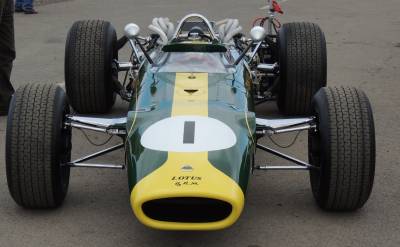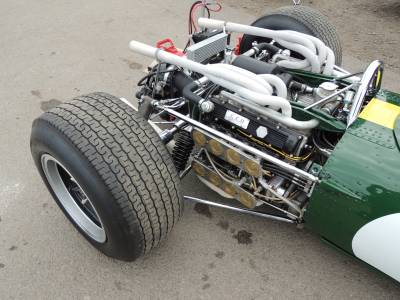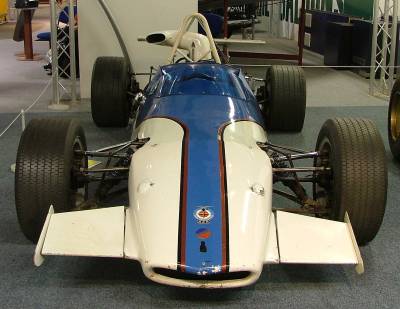 The British
Racing Motors (unofficial)
information centre.
The British
Racing Motors (unofficial)
information centre. The British
Racing Motors (unofficial)
information centre.
The British
Racing Motors (unofficial)
information centre.
- the "other" cars -
 BRP-BRM
V8 1.5litre Formula One
BRP-BRM
V8 1.5litre Formula One
(Photograph - BRM Track Day, Blyton - 22 April
2015) ..................... More Photos in my Flickr album - BRM Track Day - Blyton 22 April 2015)
The British Racing Partnership (including the Stirling Moss family and Ken Gregory) ran various Formula One cars that they ran as private entries in the 1950s and early 1960s. The team eventually became a manufacturer in their own right.
The first appearance of the Tony Robinson BRP monococque was in the Belgian Grand Prix at Spa 1963. The team withdrew at the end of 1964. The cars used BRM engines and gearboxes.
Chrysler (Hillman) Avenger 1.6litre
This high performance version of the family run-about used
a "Chrysler-BRM" 1600cc Avenger engine. The BRM
conversion used a 16-valve alloy head operated by chain drive
twin cams. The engine capacities were 1598cc and also 1798cc
& 2000cc (which gave 205bhp). The car gave Chrysler/Hillman a
package powerful enough to compete in rallying. Production of the
car ran between 1974 and 1977.
Cooper T86-BRM V12 3litre Formula One
In 1968 Brian Redman & Lucien Bianchi scored third
places at Spain & Monaco during the last year of the Cooper
Grand Prix team's career.
Gilby-BRM V8 1.5litre Formula
One
Amateur racing driver and wartime fighter pilot Sid Greene
had set up the Gilby Engineering Co Ltd. From 1954 he ran his own
private entrant racing team using Maserati 250F and Cooper T45 -
Maserati F1 cars. Greene and designer Len Terry (later to design
for the BRM works team) raced their own sportscar in 1960 and in
1961 produced a 1.5-litre spaceframe F1 car.
For 1962 another F1 car was designed around the Championship winning BRM V8. At the German GP around Nürburgring Sid's son, Keith, retired the car due to collapsed front suspension. At Enna, Italy Keith finished seventh. The Italian GP at Monza registered a non-qualification. The team closed at the end of 1962.
The Gilby-BRM was used by privateer Ian Raby during 1963 season. Ian's three World Championship races resulted in two non-qualifications and a 19th place in the British GP. Best result of the year was third in the Rome GP, Vallelunga, Italy. The car has survived via various owners (and even beach racing in Jersey!) and is said to be being restored.
 Lotus 43 - BRM H16
Lotus 43 - BRM H16
(Photograph - BRM Track Day, Blyton - 22
April 2015) ..................... More Photos in my Flickr album - BRM Track Day - Blyton 22 April 2015)
The H16 is often thought of as a glorious failure. In part, that may be the case. It was also a great British winner. The engine triumphed at the 1966 US Grand Prix in the richest race of that year's Championship.
At the start of the new 3 Litre formula of 1966 the Lotus team's preferred engine supplier (Coventry-Climax) had withdrawn from racing. Their own bespoke engine (the Cosworth Ford V8) would not be ready until well into the 1967 season. For 1966 the team would use oversize engines from the previous formula and become a "customer team" user of the 3 Litre BRM H16.
The Maurice Philippe designed car produced for the H16 engine was a monocoque ending behind the driver with the engine being a fully stressed member that supported the rear suspension and gearbox.
The Type 43 made its Grand Prix debut in the 1966 French GP. The Type 43 only finished one race - the 1966 United States Grand Prix. It won the race by over a lap! It was the only ever victory of the BRM H16 engine. Click here for the story of the race.
The last race of the Type 43 was the 1967 South African Grand Prix and later in the year at the Dutch Grand Prix the Type 49 Ford Cosworth DFV V8 raced for the first time. The two redundant H16 engined cars had their chassis modified for F5000 with the Ford V8 motor and were sold to Jock Russell and Robs Lamplough.
The US Grand Prix winning car (Type 43 R1) has been restored to original and working order and was first run in front of the public at the 2013 Goodwood Revival.

 and then the Lotus
43 - BRM H16 became the Lotus 49 - Cosworth V8
and then the Lotus
43 - BRM H16 became the Lotus 49 - Cosworth V8
Is this how a good try developed in the one of the classic racers?
Take a bit of weight off the
engine
add a bit more power
use a little less fuel
make the car a little smaller
become reliable
and the result is a regular winner
compare the cars at my Flickr album - BRM Track Day - Blyton 22 April 2015
Lotus Elan BRM
The light and small Elan of the 1960s provided a high performance
roadgoing two seat sportscar at a reasonable price. The racing
option for the Elan (Lotus 26R) could be provided with a BRM
tuned version of the four cylinder twin-cam Lotus-Ford engine.
One of the most active Lotus dealerships for this car was Mike
Spence (who just happened to have driven for the Formula One
teams of both Lotus and BRM.)
There were three versions of the BRM Weber
side-draft carburettor racing twin-cam.
Phase I - 145bhp. at 6,500 rpm.
Phase II - 200bhp. at 6,500 rpm.
Phase III - ? bhp. at ? rpm.
McLaren M4A - BRM V8 2.1litre
Formula One
One of the Formula Two chassis was rebuilt as a Formula
One car to fill the gap in early 1967. A 3in. extention in
wheelbase allowed the fitting of a BRM V8 2.1litre "Tasman"
engine. Extra fuel tanks were fitted to the chassis sides to
provide Grand Prix distances. The car got as high as second in
the twisty Monaco Grand Prix, finally finishing fourth after
being delayed by a flat battery. At the Dutch Grand Prix McLaren
retired on the first lap after spinning into the catch fencing.
The chassis was later burnt out and written off in an accident at
Goodwood.
McLaren M5A - BRM V12 3litre Formula One
The M4A-BRM was followed by the real 1967
Formula One McLaren - the M5A. This was the first use of the BRM
"customer" V12 whilst the works team were still using
the H16 engine. In the Canadian GP team owner, Bruce McLaren, up
to second place in the topsy-turvy rain-soaked race. What could
have been a magnificent win first time out became a finish
outside the points after a stop to replace a flat battery. The
power of the engine was shown by a front row grid position in the
Italian Grand Prix at the fast Monza track. The car was running
fourth when a broken connecting rod ended the run. The American
Grand Prix ended with a water hose failure. Mexican Grand Prix
provided a last place finish with overheating problems. The last
works use of the car was at the 1968 South African Grand Prix,
where Dennis Hulme finished fifth.
Privateer Jo Bonnier used the car until it became a wall-mounted
display in his home.
Raymond Mays 20
As well of being the “Father” of BRM, Raymond Mays was “Father” of the ERA of the 1930s and also (less well known) the “Father” of a road car using his own name.
The vehicle was based on the Standard V8 “20 horsepower” model in both touring and coupe versions. The engine actually produced 85bhp. at 5000rpm. from it's 2686cc.
Shelsley Motors Ltd., Bourne produced the cars during 1938-1939 (when the Second World War intervened).
 Rover 200 BRM LE
Rover 200 BRM LE
The photo is an publicity shot originally issued by the MG
Rover Group. Car owners will be found at "theBRM.co.uk"
Rover BRM forum.
..................... More Photos in my Flickr album - BRM Track Day - Blyton 22 April 2015
The road car, a special edition based on the Rover 200 / 25
range, was first publicly shown as a concept car at the Frankfurt
Motor Show in 1997 and was expected to be sold at around priced
at £18,000 on the road.
The three door hatch-back became available in April 1998 at about
£14,000. Originally the model was to be a special edition of 750
but finally a little over one thousand were produced. UK sales
amounted to 795 units. The Belgian market was allocated 50 cars.
The BRM model was given stiffer springs, lowered suspension, alloy 16 inch wheels and a Torsen limited slip differential. Gearing changes giving a close ratio gearbox encoraged the top end of the 1.8 VVC 143hp. rev range to be used.
The cars were painted "Brooklands Green" with chrome trim and a BRM "dayglow" orange nose. The interior was fitted with red leather and aluminium.
Scirrocco-BRM V8 1.5litre Formula One
Chassis produced - SP-1-63 & SP-2-63
Wealthy American teenager Hugh Powell brought into Emeryson Cars Ltd. to provide his guardian, racing driver Tony Settember, with a team to go Formula One racing for the 1962 season. The year with the Emeryson-Climax 4-cylinder was not a great success.
For 1963 Powell took full control of the team, renamed it “Scirocco-Powell” and developed a redesigned chassis to take the BRM-V8 that had taken the 1962 World Championship. Two chassis were built Scirocco-BRM (SP-1-63) for Tony Settember and later a narrower Scirocco-BRM (SP-2-63) for the team’s second driver, the narrower Tony Burgess. The team raced under the USA national colours of blue and white.
The cars’ greatest day was when Settember took Scirocco-BRM (SP-1-63) to a second place in the 1963 Austrian GP, only beaten by ex-World Champion Jack Brabham. The story was not quite as good as it seemed as the non-championship race only had three finishers and Tony was five laps behind Brabham.
Otherwise the year was no more successful than 1962 and by the end of Powell closed the team and both cars were sold. In 1964 Belgian Andre Pilette raced SP-2-63 with a Climax V8 engine and the Belgian national racing colour of yellow. Having being recovered from long-term storage in a Bristol mill in 1991 the chassis was later rebuilt by Hall & Fowler. Hall & Hall (as Hall & Fowler are now known) are restoring both chassis.
Talbot Sunbeam BRM
I spotted this advert - no other information currently available.
"This is UK’s monthly Performance Tuning dated October 1988, 84 pages. In this issue there is coverage on: The Hartwell BRM 16-valve Sunbeam Lotus Talbots are reviewed in an interesting article. Good engine photos…"

(photo left and right Jul 2009)
The 1967 Techcraft-BRM at the Museum of British Road Transport, Coventry .
The car uses the Ferguson 4WD system and a 1500cc. BRM V8 Grand Prix engine.
The car is described ........
"RAC Hill Climb Champion 1967-1968 driven by Peter Lawson
Engine later enlarged to 1600cc and later still returned to 1500cc
Later raced by Roy Lane of Warwickshire who rebuilt the car."
The car was later used by Dave Baumforth.
V1.6 - 25 April 2015 ---- recommended resolution (1366 x 768)
© David Hodgkinson 2000-2015. All rights reserved.